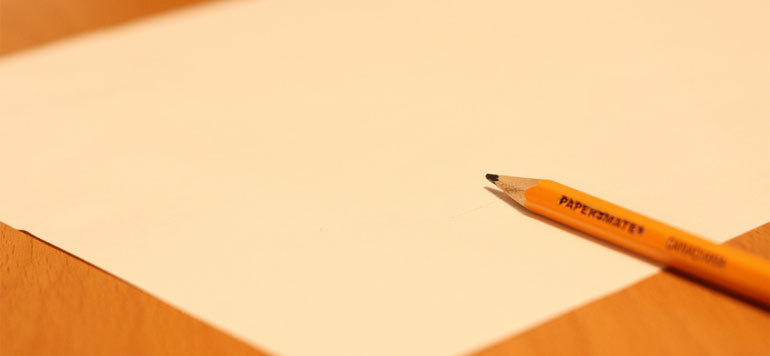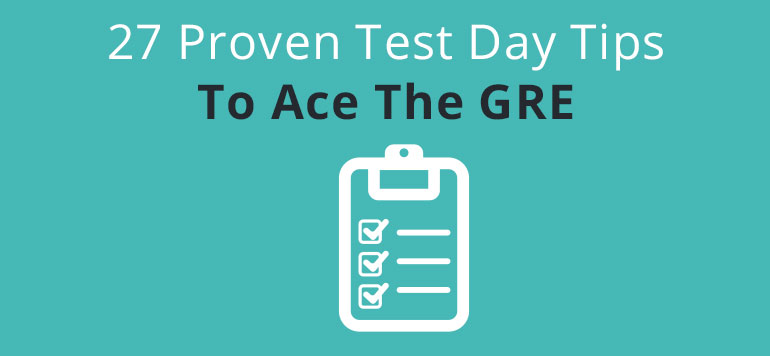There’s a beautiful quote from the movie ‘Life is Beautiful’ that says “Nothing is more necessary than the unnecessary.” It’s funny how it can be applied to your GRE exam as well.
Most students underestimate the importance of the scratch paper on the GRE exam. It might seem unnecessary to worry about something as trivial as the scratch paper, especially when there are other important things to take care of during the test. But why do you need a scratch paper in the first place? Because, trying to do more than one step mentally, without writing anything down, will end up taking more time and will lead to lots of errors.
On the other hand, the scratch paper can be vital for you to score higher on the GRE, as it helps you calculate better, avoid or reduce mistakes, save precious time, and at the end of the day, do well on the test. Using the scratch paper in an organized way will keep you calmer and more focused than you would otherwise be.
The Answer Grid Method:
Think about it. If you are writing a paper based test and you have multiple choice type questions on the test, how would you approach the answer? The easiest way is to follow the process of elimination. And what do you do when you eliminate the answer options? You strike them off one by one, and try to narrow down your choices, to make it less complicated. This process is fairly obvious and is also extremely effective.
But what if you are writing a computer based test, like the GRE?
You cannot strike off options on the screen, and all you have is some scratch paper and a pencil. How do you use a pencil and a piece of paper to make your test easy? Like Dr. Seuss said, ‘Sometimes the questions are complicated and the answers are simple.‘ The pencil paper combination is all that you need now, to score higher on the test.
If you are like many students, your natural inclination is to take a fresh sheet of paper for your first problem, write down some information, maybe an equation, or a diagram. Good for the first problem you are working on. And probably good for the second one, too. By the third problem, you’re writing around the edges of the first two problems, and if you get confused, you can’t figure out what you’ve already done since your work is all over the place. So, how do you avoid this clutter and make it easier to solve problems?
Make way for ‘The Answer Grid’, for it comes in handy in such a situation. By drawing a simple grid and labeling the rows with options A to E and the columns with question numbers, and by striking off the options you want to eliminate, you can easily keep track of the answer choices throughout the test.
You should make an answer grid just like the one below on every quant and verbal question you come across on the test:
A
B
C
D
E
This method has proven to be extremely useful to students, especially during the verbal section. Imagine you have just read a long RC passage, and the answer options to the questions are long sentences that take time reading and understanding. In such a situation, if you don’t have an answer grid, it becomes very difficult to remember which answer option is right. But, if you have an answer grid ready, you can strike off the options the moment you think they are unrelated or wrong. This way, you can narrow down your options and save time. The same technique can also be used for other Verbal and Quant questions as well.
Important Note:
You will be given scratch paper just before your exam begins, and you are not allowed to write anything on it until the clock starts ticking. Does that mean you will only be wasting precious exam time by preparing an answer grid?
No. Preparing an answer grid won’t take more than a couple of minutes, and you can buy some time from the AWA section. This means, you will not lose out on previous exam time and at the same time, prepare yourself an answer grid as well. Practice doing this as many times as you can at home, and it will be a piece of cake during the real test.
Also, you don’t have to take any stationery with you. Even if you do take them to the test center, you will asked to put them away, since they aren’t allowed inside the testing area. The proctor gives you scratch papers, pencils and erasers, and will also refill them if you need. So, don’t worry about taking things to the center by yourself. Also, you will be given as many scratch papers as you need, no questions asked. So, don’t hesitate to ask.
Some other important Scratch paper tips:
1. No notebooks, please!
While practicing, use scratch papers only. Some students have the habit of using notebooks as scratch papers, but it is best to replicate the test environment as much as possible. So, using scratch papers during practice tests will only help you during the real exam.
2. The pencil is mightier than the pen
You will be given pencils and an eraser during the real GRE, so it makes sense to practice in a similar manner. Instead of a pen, try using a pencil while attempting practice tests at home. Sometimes using the pencil can cause you a bit of discomfort, especially if you haven’t used it since high school, so it is better to avoid strange experiences on test day by practicing at home with a pencil and eraser.
3. Don’t waste time erasing!
Try to avoid using the eraser as much as possible. Using an eraser can have a few drawbacks that you can easily avoid. First, it takes more time to erase and write again. Second, it sometimes may tear the paper if you erase hard, which is likely because you will be under stress. You can as well strike off whenever you make a mistake and write again, just as you would do with a pen. This not only saves you that extra five or ten seconds per mistake, but also saves you from asking for a new paper because you’ve just torn the last one.
4. Strike off for clarity
When you are solving so many math questions on a single piece of paper, there obviously would be a lot of numbers, calculations and strike offs. And more often than not, when students solve around ten to fifteen questions on a paper, they get confused with the numbers on the sheet. But if you follow a systematic practice, there will never be a chance for confusion. As soon as you finish a question, draw border lines around it, and strike of the entire part twice (like an X). This gives you a clear distinction between questions, and you can always concentrate on your current question.
5. Circle your numbers
Since you will anyway be drawing border lines for each question, write the question number inside the box and encircle it. This helps you when you mark a question and come back again at a later point. If your questions are numbered, it is easier to find the question you are looking for, so you won’t have to start the rough work from scratch again. You can as well continue from where you left off. This saves quite a few minutes of your time during the test.
6. Unlimited supply of paper
You will be given as many scratch papers as you need, no questions asked. Every set has six new scratch papers, and you’ll get a new set as soon as you finish the previous one. So, don’t hesitate to ask for an extra paper every time you need. There are times when you should not be an environmentalist. This is one.
But remember, whenever the proctor brings a new set of papers, the previous set will be taken away. This is extremely important, because you will have some unanswered or marked questions during the test, and you may have already done some rough work to those questions during the first attempt. But if the proctor takes that scratch paper away, you will have to start all over again, when you revisit those questions later. So, make sure you ask for a fresh set for every new section, so you’ll have all questions together.
7. Bigger numbers, lesser problems
Because you can have an unlimited supply of scratch papers, make full use of them. Do only a few problems per page, and make sure you follow the answer grid format. Because when you do a lot of questions on one paper, you’ll sometimes overlap questions, and this leads to confusion as to which numbers belong to which question. So, write bigger numbers and avoid getting confused.
8. Consult the proctor
Sometimes, the proctor may ask you to return all your previous scratch papers before issuing you new ones. There is no fixed policy regarding this, and it may depend on the test center and the proctor. So, it is better to ask the proctor before the exam if there is any such policy.
9. Practice makes you perfect!
Remembering all these points during the test is of course difficult, and it is possible that you may forget one or more of these techniques. And the best way to avoid that is; yes you’re right: Practice. Practice these techniques at home as many times as possible, whenever you are taking a practice test, or even when you are just solving problems for fun. This way, there won’t be any need to remember stuff. These techniques will soon be a part of your test taking style.
Conclusion
The scratch paper is a precious tool on the GRE that you should use effectively. So, those are the 9 effective scratch paper tips you should use on the GRE.
Do you know any other scratch paper strategies? Share with us and we’ll be happy to add them to the list 🙂





another useful post i can relate to. i was looking for some new gre tips and glad i ended up here. thanks a ton.
Glad we could be of help, Abdul! 🙂
Great article. I found several useful tips regarding scratch papers. Thanks for putting it up. 🙂
Glad you found it resourceful, Akash! Let me know how it works out for you. 🙂
Hi Jitta! I found this very useful. Thanks alot. As minor as it may sound, the scratch paper is actually very important
Linda, glad you found them helpful. Looking forward to hearing more from you. Just out of curiosity, which ones did you find most helpful?
Great article! Not only this one but all of them!
Great job! Cheers!
Wow. This is such a great resources. Thanks for posting 🙂
Hemchand, glad you found it resourceful. Thanks for the feedback.
very helpful, thank you! didnt even think to use a new sheet for each section.
Wow such a fabulous article, your blog has a great content.
You people are doing a great Job, Jitta and Sachin. All of your blogs are fantastic and resourceful.
Thank you so much!
New title
Download The Free GRE Guide (Valued at $30)
Also get Free GRE tips directly in your inbox!